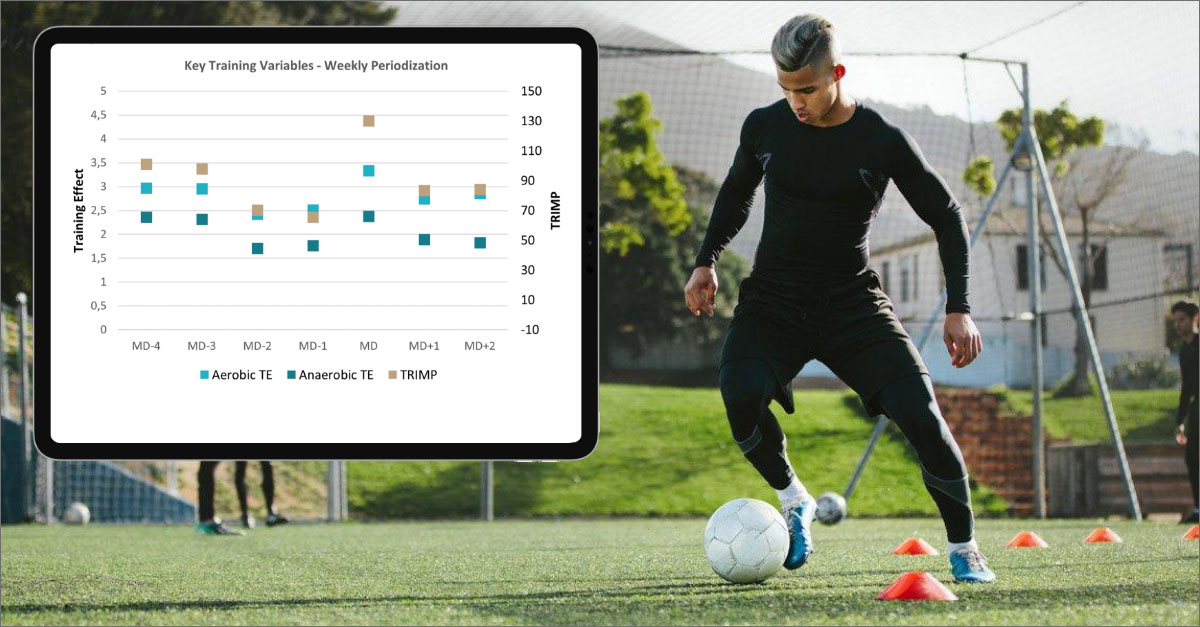
Preparing for each game is perhaps one of the most important considerations when coaches are planning their weekly training schedule, as they aim to arrive at game day with players as fresh as possible.
There are many different models and variations on how to structure the game week, I’ve included some examples below that were used during my own time working with teams, but the same theme runs through all of them and that is a taper of training loads into the game day. Of course, the specific plan each week can change depending on the context of that phase of the season, with factors such as fixture congestion and/or accumulated fatigue over the course of the season likely to be considered.
Soccer Training Load Trends Leading Up to Match Day

Table 1. Examples of weekly periodization models used in soccer for a 1 match per week schedule.
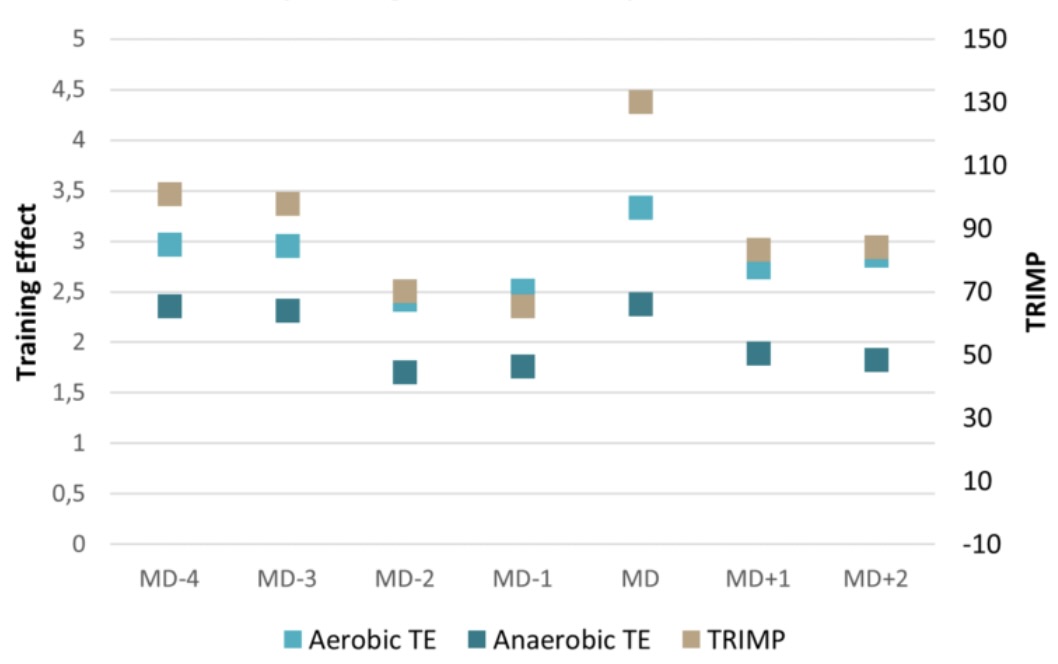
Figure 1. Key Training Variables – Weekly Periodization. Training Effect and TRIMP.
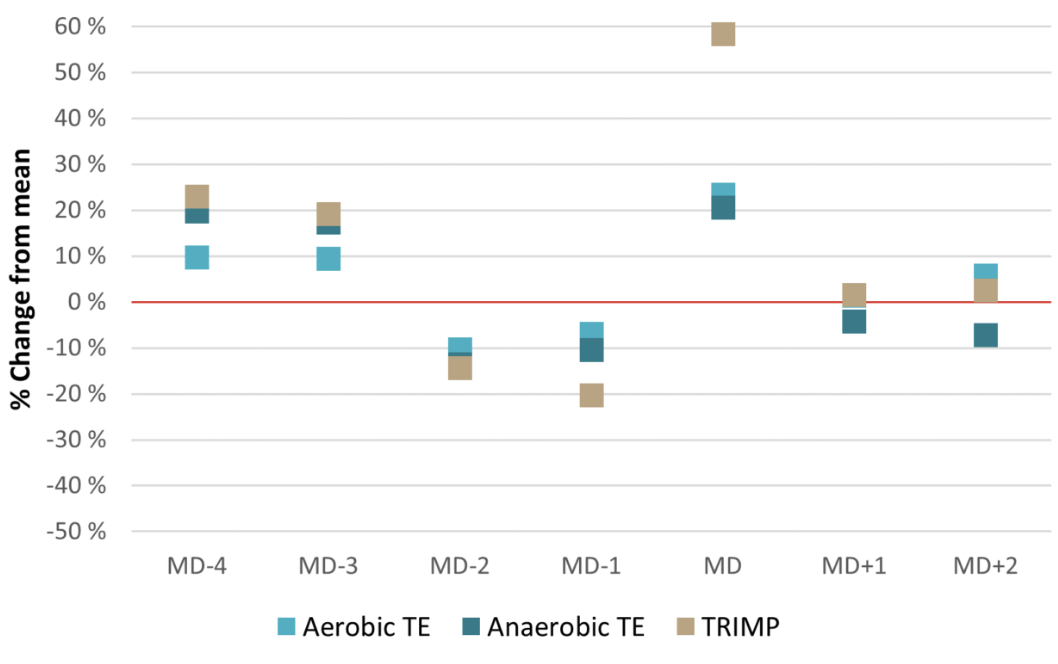
Figure 2. Key Training Variables – Weekly periodization. % Change from mean.
We decided to look at what this means for Firstbeat Sports users and attempt to identify some trends with the data for periodization leading into match days. We found a clear drop off in both volume and intensity as teams reached Match Day -2 and -1 (i.e., the two days directly before a match.)
It’s important to note that we do not know the specific context or content of the measurements in the database, or the particular models of periodization adopted by each team. What we can see however is the clear taper towards a match, and this is a good strategy to adopt to ensure your players aren’t carrying too much fatigue into a match when you want them to be as fresh as possible. The Match Day values on those charts may look a little low to fully reflect, and that is likely true; we cannot differentiate which measurements are from match play or those which are training sessions that occurred on a match day, such as a rehab session or simply a player who was not selected for the match.
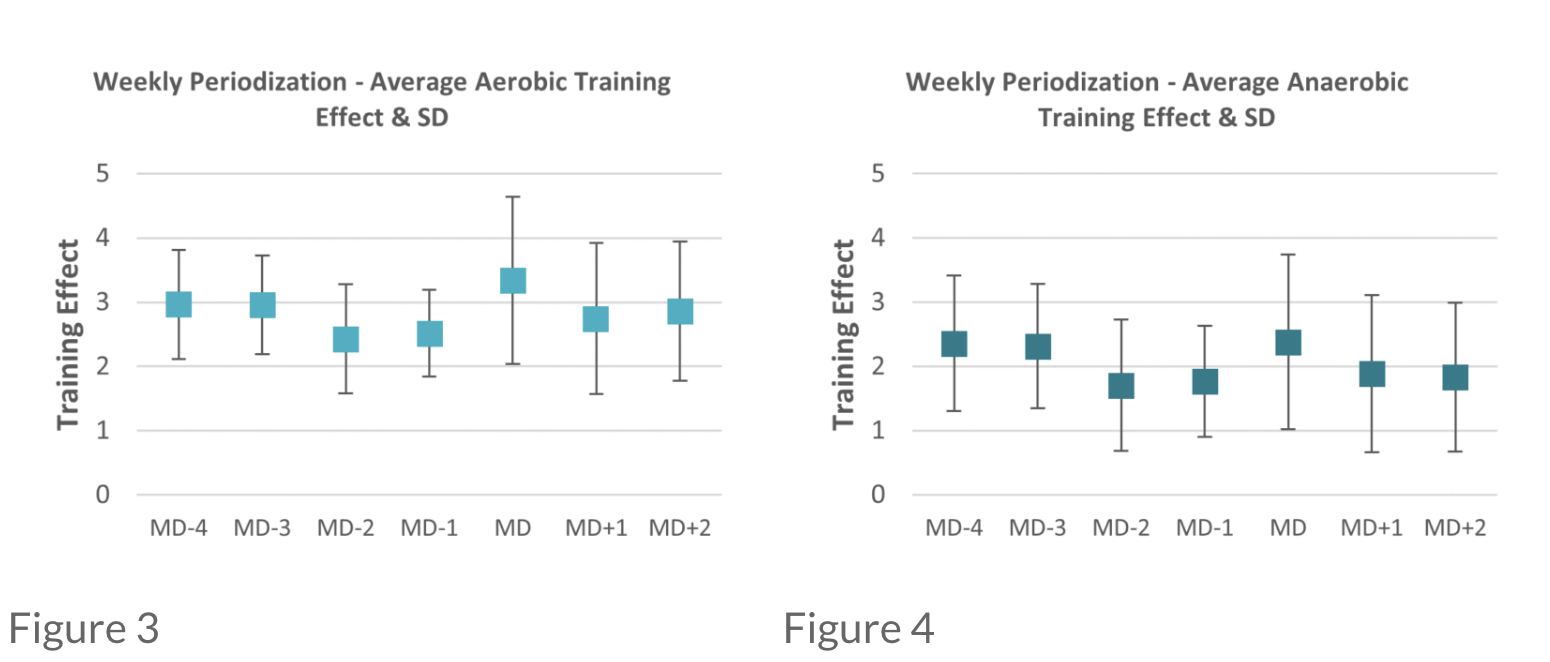
One interesting observation is the decrease in volume, but slight increase in intensity (measured by Training Effect) between Match Day -2 and -1 (see Figures 1 and 2). This fits with the narrative that teams want minimal volume the day before a match, but still to maintain intensity in order to act as an activation. It also matches some periodization principles from other areas like endurance sport, whereby volume decreases in a taper toward event day but some intense sessions are programmed as a primer for the competition (Mujika & Padilla, 2003). This helps prevent any ‘staleness’ being introduced into the players/athletes as they approach competitive action (Goeringer, 2023).
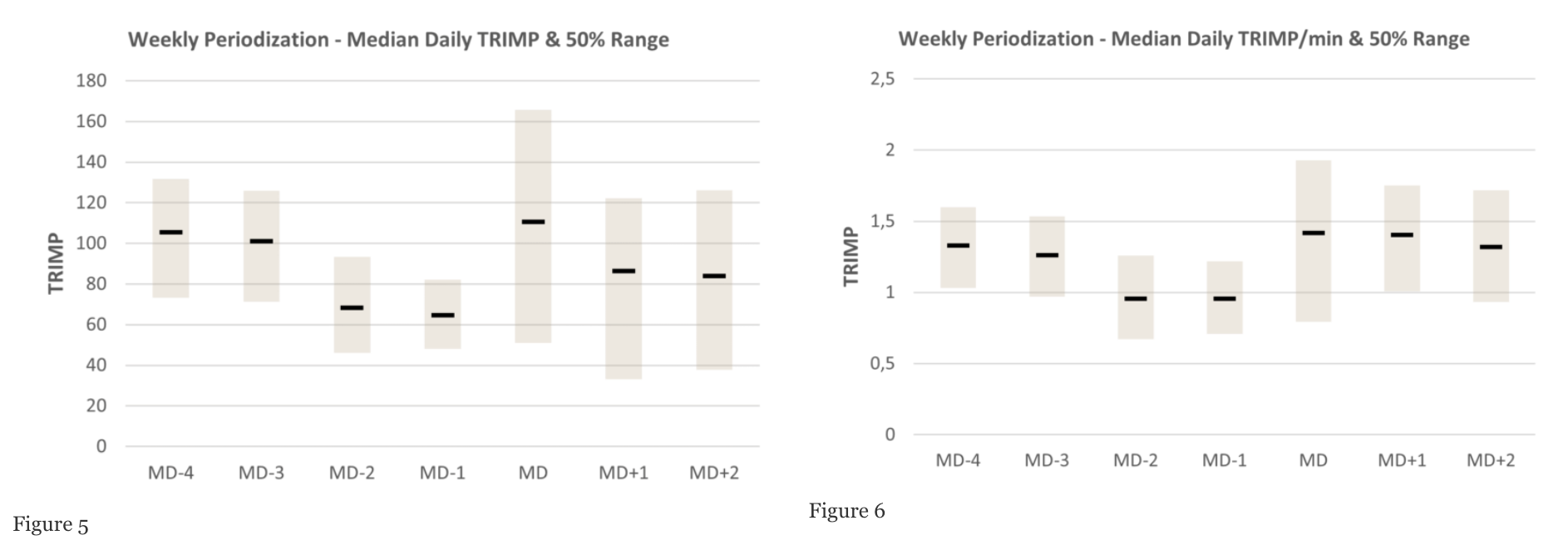
When we then look at the variance across the week, we can see that MD-1 was the most consistent regardless of the periodization model being applied. The volume was lowest and the range encompassing the middle 50% of measurements is relatively narrow, whereas the median TRIMP for Day -2 is only slightly higher but the 50% range is much wider (see Figure 5). This tells us that there is more variation in how different teams approach Day -2 compared to Day -1.
The greatest variation however appears to be in the 2 days after matches. This is not entirely surprising when we consider some of the general models that are commonly utilized as shown in Table 1. Some teams will have Day +1 as a complete day off, others may use it as a recovery or top-up day depending on minutes played. We can see that the TRIMP/min values between Match Day and Day +1 are very similar (Figure 6), which implies that teams often look to work at a level similar to match play. However, as seen in the TRIMP chart (Figure 5) the total amount of training is typically less than a full match. For teams capturing their recovery session we should keep in mind that the specific activities can vary greatly, from off-feet or pool-based activities to pitch-based but limited football. You could conceivably have players at both the top and bottom of the +1 range from within the same team; those who played significant minutes the day before may just do a light spin on a stationary bike while those who did not play do a hard session to replicate the demands of match-play.
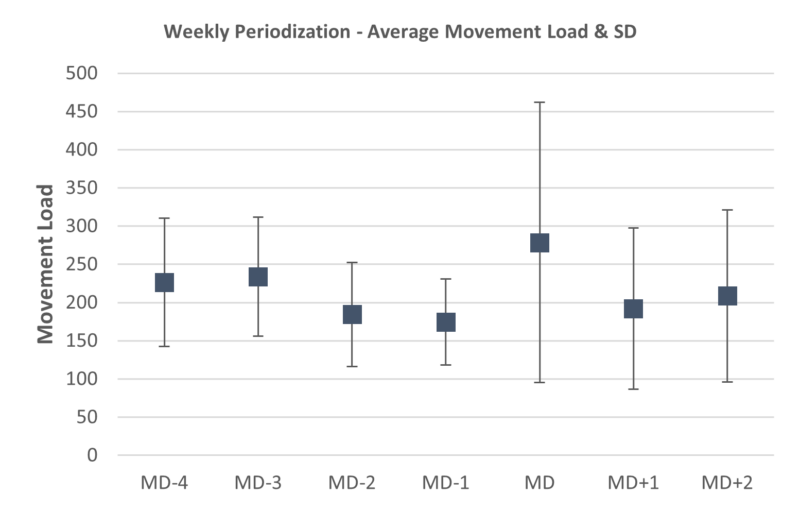
Figure 7
Movement Load Trends Leading Up To Match Day
The daily variation in Movement Load (ML) is broadly similar to TRIMP (Figure 7) but also paints an interesting picture and points toward the widespread use of Tactical Periodization (Delgado-Bordonau & Mendez-Villanueva, 2012; Kyprianou & Farioli, 2020), as per Example B shown in Table 1.
We can see that total ML increases slightly from MD-4 to MD-3, which is the opposite of what we observe in TRIMP patterns. This suggests the use of Tactical Periodization as when utilizing that model the MD-4 will typically focus on small playing areas and short but very intense work periods, sometimes termed as ‘Strength’ or ‘Resistance’ sessions. MD-3 will then switch to bigger areas and longer work periods, so players are covering more ground but at slightly lower intensities, and this is typically referred to as an ‘Extensive’ or ‘Endurance’ session. This is further evidenced by overall Aerobic TE being very close between the two days, but Anaerobic TE being higher for MD-4 with a more even set of work: rest ratios.
Conclusion
What can we conclude from the data? There is a clear decrease in training volumes as teams approach match day, the further we travel back from match day the greater the variance in terms of volume of work and intensity. However, the greatest variation is present in the days after matches, which is unsurprising as these days will deal with both players recovering from those matches whilst also ensuring the non-playing/low-minute members of the teams receive sufficient training to maintain their fitness for when they are required to play.
Want to talk about your teams situations with Firstbeat Experts?
References:
Delgado-Bordonau, J.L., & Mendez-Villanueva, A. (2012). Tactical Periodization: Mourinho’s Best-Kept Secret? Soccer Journal, 57, 28–34.
Goeringer, C. (2023). Athlete Tapering FAQs All Endurance Coaches Need to Know. Training Peaks: Coach Blog. https://www.trainingpeaks.com/coach-blog/endurance-coaching-tapering-faqs/ [Accessed 02 November 2023].
Kyprianou, E., & Farioli, F. (2020). Let’s Talk About Weekly Plans in Soccer. Complementary Training. https://complementarytraining.net/lets-talk-about-weekly-plans-in-soccer/.
Mujika, I., & Padilla, S. (2003). Scientific Bases for Precompetition Tapering Strategies. Medicine and Science in Sports and Exercise. 35(7), 1182-1187.
You might also be interested in

Make Confident Coaching Decisions with Firstbeat’s Weekly Reporting
In this article, we’ll introduce the Weekly Reporting feature from Firstbeat Sports. As a coach, you can use this feature to: See key training load data over a 7-day period…

Maximizing Athletic Performance with Lap Management: A Comprehensive Guide
Unlocking the full potential of your athletes and optimizing training requires a strategic approach. The Lap Management tool is your key to achieving this. In this comprehensive guide, we’ll explore…

Gaining Athlete Buy-In – Ideas and Strategies for Successful Monitoring
The key to any successful monitoring strategy in sports is having buy-in from the athletes. Without athlete buy-in, it will likely be difficult to get reliable and valid data. Of…


